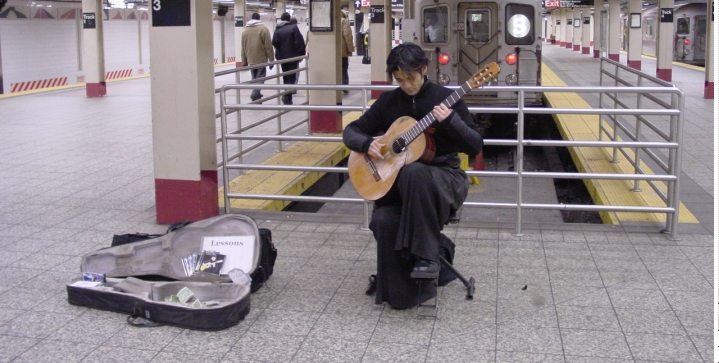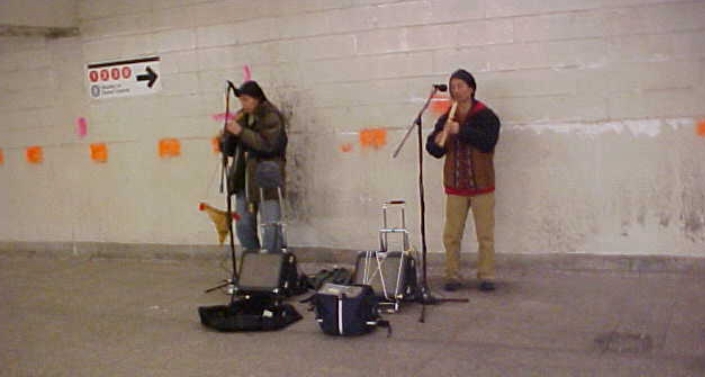Alex Case- alex@fermata.biz
fermata audio + acoustics
P.O. Box 1161
Portsmouth, NH 03802
Popular version of paper 4pAA6
Presented Thursday afternoon, May 27, 2004
147th ASA Meeting, New York, NY
No celebration of acoustics in New York City would be complete without mention
of the many alternative spaces used for the performance of music, dance, and
other art forms. New York's countless train stations, parks, alleys and overpasses
provide popular venues for artists to make sound. Lincoln Center and Carnegie
get all the glory, but it's the streets and train stations that do all the work.
Consider the business side of subways stations alone: With 7,000,000 passengers
circulating through the New York Subway system each business day, subway stations
offer an enormous audience. Let's round down, and say that only one in ten passengers
pays any attention to the music. To match this audience size of 700,000 people,
we'd need an unachievable number of sold out shows at Lincoln Center and Carnegie
Hall. In fact, it would take 54 sold out shows per day at the three main stages
of Lincoln Center (Avery Fisher Hall, Metropolitan Opera House, and New York
State Theater) plus all three stages at Carnegie Hall (Stern Auditorium, Weill
Recital Hall, and Zankel Hall) to match the popularity of these underground
performances. New York City's best-heard performance hall is the subway station.
Does the acoustics matter? Your author, an unabashedly biased acoustician, says,
"Yes!"
One reason we sing in the shower is that the space amplifies our voice, acoustically.
Microphones, loudspeakers, and amplifiers aren't required (and are in fact strongly
discouraged). Yet our voice gets louder. The hard walls - typically made of
tile, stone or some kind of rigid, heavy material - contain the sound energy
within the shower, allowing a build-up of sound pressure level. Even if we lack
the singer's strength and technical training, singing in the shower gives us
a strong sense of possessing a singer's 'pipes.'
Subway stations provide a similar acoustic environment. Tile, steel and concrete
reflect and encapsulate the sound, letting the subway station provide support
to the music within. The musicians wallow in it. The passengers variously savor,
ignore or avoid it.
In the creation of Symphony Halls and Opera Houses, where music occurs without
electronic amplification, this confinement of sound energy is a fundamental
design principle. One may consider the formal music performance hall an exercise
in the strategic conservation of sound energy. Materials are chosen to contain
and preserve the sound within the hall. Liberal use is made of hard wood, stone,
concrete and plaster to reflect the sound back into the room. Designers try
to keep the sound energy in. They try to conserve the precious sound energy
created by all those musicians at the front of the hall so that we can hear
it in the back of the hall. In fact, the audience (a necessary element in any
successful hall design) tends to be the single greatest absorber of sound energy
in these spaces. Listen to a hall unoccupied by all those absorbers, um, I mean
people, and the hall sounds very different indeed.
Acousticians keep track of the Strength Factor in hall design, which is a mathematical
comparison of the sound pressure within in a hall versus the sound pressure
of that same sound source without the hall. Perform music in a place completely
lacking sound reflections, and the sound dissipates immediately. That is, perform
music in the quiet outdoors, with no ceiling and no walls to contain the sound
and you'll strain to be heard. The enclosed space of a hall or an opera house
provides acoustic gain much like a home audio amplifier provides electrical
gain. Showers and train stations excel at this. And the train station performers
know this. They seek out locations near hard walls and under low ceilings so
that their sound is amplified above the din of the station.
Consultants in acoustics are reminded on every project that the success of any
hall doesn't just rely on the room size, geometry, and finish materials that
those in attendance can easily see. Much attention, and therefore much money,
is spent on the unseen infrastructure around the hall to make the space quiet
first. The noise and vibration of the city surrounding the hall, as well as
that of the heating system, air conditioning equipment, elevators and plumbing
that serve the hall all must be controlled and attenuated to a reasonable level.
With these distracting sounds reduced, the music is more easily enjoyed.
While the subway station is rarely a quiet place, the musicians understand the
sonic benefit of relative quiet. Train platforms with only one line are much
preferred to those with four or more. The music happens between noisy train
arrivals and departures, not during. Train stations with a steady stream of
announcements are avoided. Sorry to say, the musicians and other performers
you watch while waiting for the train are actually hoping for delays. This extends
the period of relative quiet so their work can be heard.
Music in train stations honors much of what is known about the acoustics of
performance spaces. Musicians cozy-up to reflective walls and ceilings in search
of acoustically supportive sound reflections. And they choose their spots carefully,
finding spaces within the urban noise floor to get their work heard.
 |
Figure 1: Hard surfaces and low ceilings offer desired acoustic support.
 |
Figure 2: Musicians commonly situate themselves directly in front of the sound-reflective
tile walls of subway stations.